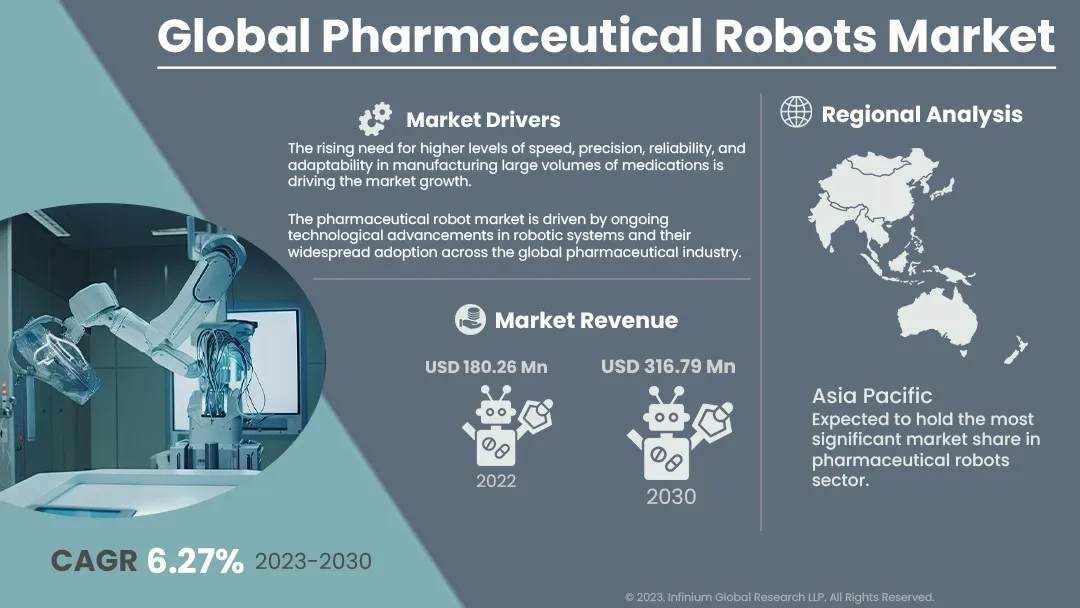Pharmaceutical Robots Market (Type - Traditional Robots, and Collaborative Pharmaceutical Robots; Application - Drugs Inspection, Picking and Packaging, and Laboratory Applications): Global Industry Analysis, Trends, Size, Share and Forecasts to 2030
A recent report published by Infinium Global Research on pharmaceutical robots market provides in-depth analysis of segments and sub-segments in the global as well as regional pharmaceutical robots market. The study also highlights the impact of drivers, restraints, and macro indicators on the global and regional pharmaceutical robots market over the short term as well as long term. The report is a comprehensive presentation of trends, forecast and dollar values of global pharmaceutical robots market.
Market Insight:
Robots have become invaluable assets in life sciences, laboratories, and pharmaceutical applications, surpassing human capabilities in multiple aspects. They excel particularly in pharmaceutical manufacturing tasks due to their superior speed, cost-effectiveness, and consistency when compared to human labor. These robots operate at a pace that is three to four times faster than human workers and can operate continuously, 24 hours a day. Furthermore, they are meticulously designed to meet the stringent hygiene and precision requirements of the pharmaceutical industry. In the realm of pharmaceutical manufacturing, robots play a pivotal role in a wide spectrum of tasks, including machining, assembly, dispensing, machine operation, material removal, pick-and-place operations, ultrasonic welding, and test handling. According to the Association for Packaging and Processing Technologies (PMMI) in August 2023, it was projected that by the next five years, robots would have been integrated by 100 % of the companies for primary packaging facilities within the pharmaceutical sector, demonstrating their growing importance in the industry.
Pharmaceutical robots are pivotal in streamlining the production of large medication volumes, demanding higher levels of speed, precision, reliability, and adaptability. These indispensable efficiency criteria are achieved through process automation using robotic systems. Furthermore, the pharmaceutical robot market is propelled by continuous technological advancements in robotics and their widespread integration into the global pharmaceutical industry. However, it's important to note that the substantial investment required for automated manufacturing in the pharmaceutical sector may pose challenges to the growth of the Pharmaceutical Robots Market. Nevertheless, there is a silver lining as key industry players are consistently introducing state-of-the-art robotic machinery to optimize manufacturing processes. This proactive approach creates promising growth prospects for the Pharmaceutical Robots Market in the foreseeable future.

The Asia Pacific (APAC) region is expected to hold the most significant market share in pharmaceutical robots sector, with the largest market share, closely followed by Europe. This can be mainly attributed to the significant presence of major pharmaceutical companies in countries like Japan and China, which is anticipated to be a key driver of market growth in this region. According to data from the International Federation of Robotics (IFR), China leads as the largest market for industrial robots, further underscoring APAC's prominence in this industry. Moreover, many countries in the APAC region offer third-party drug manufacturing services, bolstering their position in the pharmaceutical robots market. Additionally, due to the exceptionally high population in the APAC region, there is substantial demand for pharmaceutical products and medicines, driven by the increasing prevalence of chronic illnesses and influenza. As a result, numerous pharmaceutical companies are establishing a strong presence in the APAC region to tap into this growing market. Europe also commands a significant share in the pharmaceutical robot market, thanks to the widespread adoption of robotics in countries such as Germany, France, and the United Kingdom. Looking ahead, the North American region is poised to provide substantial growth opportunities for this market in the coming years. This can be attributed to the presence of pharmaceutical companies in the United States and a strong inclination towards automation to enhance operational efficiency within the pharmaceutical sector.
Report Scope of the Pharmaceutical Robots Market:
| Report Coverage | Details |
|---|---|
| Market Size in 2022 | USD 180.26 Million |
| Market Size by 2030 | USD 316.79 Million |
| Growth Rate from 2023 to 2030 | CAGR of 6.27% |
| Largest Market | Asia Pacific |
| No. of Pages | 180 |
| Market Drivers |
|
| Market Segmentation | By Type, and By Application |
| Regional Scope | North America, Europe, Asia Pacific, and RoW |
Segment Covered
The report on global pharmaceutical robots market covers segments such as type, and application. On the basis of type, the sub-markets include traditional robots, and collaborative pharmaceutical robots. On the basis of application, the sub-markets include drugs inspection, picking and packaging, and laboratory applications.
Companies Profiled:
The report provides profiles of the companies in the market such as FANUC CORPORATION, Kawasaki Heavy Industries, Ltd., ABB, SHIBUYA CORPORATION, Marchesini Group S.p.A., Mitsubishi Electric Corporation, YASKAWA ELECTRIC CORPORATION, Seiko Epson Corporation, Universal Robots A/S, and Others.
Report Highlights:
The report provides deep insights into demand forecasts, market trends, and micro and macro indicators. In addition, this report provides insights into the factors that are driving and restraining the growth in this market. Moreover, The IGR-Growth Matrix analysis given in the report brings an insight into the investment areas that existing or new market players can consider. The report provides insights into the market using analytical tools such as Porter's five forces analysis and DRO analysis of the pharmaceutical robots market. Moreover, the study highlights current market trends and provides forecasts from 2023-2030. We also have highlighted future trends in the market that will affect the demand during the forecast period. Moreover, the competitive analysis given in each regional market brings an insight into the market share of the leading players.
Please Choose One of them.